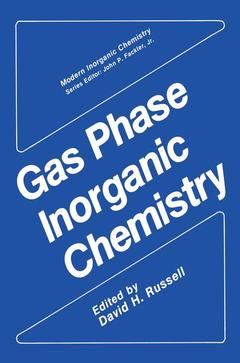Gas Phase Inorganic Chemistry, Softcover reprint of the original 1st ed. 1989 Modern Inorganic Chemistry Series
Langue : Anglais
Coordonnateur : Russell David H.

The field of gas phase inorganic ion chemistry is relatively new; the early studies date back approximately twenty years, but there has been intense interest and development in the field in the last ten years. As with much of modern chemistry, the growth in gas phase inorganic ion chemistry can be traced to the development of instrumentation and new experimental methods. Studies in this area require sophisticated instruments and sample introduc tion/ ionization methods, and often these processes are complicated by the need for state-selecting (or collisionally stabilizing) the reactive species in order to assign the chemistry unequivocally. At the present level of experimental development, a wide range of experiments on diverse ionic systems are possible and many detailed aspects of the chemistry can be studied. Gas Phase Inorganic Chemistry focuses on the reactions of metal ions and metal clusters, and on the study of these species using the available modern spectroscopic methods. Three of the twelve chapters cover the chemistry of ionic monometal transition metal ions and the chemistry of these species with small diatomics and model organics. Two of the chapters focus on the studies of the chemical and physical properties of (primarily) transition metal clusters, and these chapters review experimental methods and capabilities. Two chapters also deal with the chemistry of transition metal carbonyl clusters, and these chapters address issues important to cluster growth and activation as well as the characterization of such species.
1 Reactions of Atomic Metal Ions with H2, CH2, and C2H6: Electronic Requirements for H—H, C—H, and C—C Bond Activation.- 1. Introduction.- 2. Ior Beam Techniques.- 3. Thermochemistry.- 4. Reactions with Dihydrogen.- 5. Reactions with Methane.- 6. Reactions with Ethane.- 7. Summary.- References.- 2 Nucleophilic Addition Reactions of Negative Ions with Organometallic Complexes in the Gas Phase.- 1. Introduction.- 2. The Flowing Afterglow Method.- 3. Mononuclear Transition Metal Carbonyls.- 4. Transition Metal Arene, Cyclopentadienyl, and Diene Complexes.- 5. Catalysis Intermediates.- 5.1. Hydroxycarbonyl Complexes and the Homogeneously Catalyzed Water-Gas Shift Reaction.- 6. Concluding Remarks.- References.- 3 Reactions in Ionized Metal Carbonyls: Clustering and Oxidative Addition.- 1. Mass Spectrometry of Metal Carbonyls.- 3. Ligand Substitution Reactions.- 4. Oxidative Addition Reactions of Atomic Transition Metal Ions.- 5. Reactions of Polynuclear Metal Carbonyl Ions with Alkanes ..- 5.1. Reaction of Diatomic Metal Carbonyl Ions.- References.- 4 Structure-Reactivity Relationships for Ionic Transition Metal Carbonyl Cluster Fragments.- 1. Electron Deficiency Model.- 2. Cluster Valence Molecular Orbital Model.- 3. Bonding of Fe(CO)x in Heterometallic Ionic Cluster Fragments.- 4. Metal-Metal and Metal-Ligand Binding Energies in Ionic Cluster Fragments of Transition Metal Carbonyls.- References.- 5 Metal and Semiconductor Cluster Ions.- 1. Introduction.- 2. Methods for Generating Cluster Ions.- 3. Methods for Studying Cluster Ions.- 4. Carbon Cluster Ions.- 5. Silicon Cluster Ions.- 6. Aluminum Cluster Ions.- 7. Transition Metal Cluster Ions.- 8. Concluding Discussion.- References.- 6 Atomic Clusters in the Gas Phase.- 1. Atomic Cluster Properties and Their SizeDependence.- 2. Controlled Preparation (Synthesis) of Atomic Clusters.- 3. The Basic Experimental Measurements.- 4. Review of Results.- 4.1. Main-Group Metals (Groups 1, 2, and 13).- 5. Prospectus: Outstanding Questions.- 5.1. Where Are the Isomers?.- 5.2. The Energetics of Chemical Reactions.- 5.3. Back to the Support.- References.- 7 Time-Resolved Kinetics of Organometallic Reactions in the Gas Phase by Transient Infrared Absorption Spectrometry.- 1. Introduction.- 2. Methods for the Detection and Infrared Spectral Characterization of Organometallic Intermediates in the Gas Phase.- 2.1. Pulsed UV Photolysis Sources.- 3. Review of Recent Progress in Gas Phase Organometallic Transient Infrared Absorption Spectroscopy.- 4. Time-Resolved Infrared Absorption Spectroscopy as a Probe of Dissociative CO-for-C2H4 Substitution in Cr(CO)4(C2H4)2.- References.- 8 Characterization of Metal Complex Positive Ions in the Gas Phase by Photoelectron Spectroscopy.- 1. Introduction.- 2. Structural Information on Metal Positive Ions with Small Molecules in the Gas Phase.- 3. Electron Distribution and Bonding in the Positive Ion.- 4. Ionization Energy-Bond Energy Relationships.- References.- 9 Chemistry and Photochemistry of Bare Metal Cluster Ions in the Gas Phase.- 1. Introduction.- 2. Bimolecular Reactions of Metal Cluster Ions.- 3. Unimolecular Reactions of Metal Cluster Ions.- 4. Conclusion.- References.- 10 Photodissociation of Metal-Containing Gas Phase Ions.- 1. Introduction.- 2. Experimental Methods.- 3. Spectroscopy.- 4. Dissociation Products.- 5. Mechanistic Aspects.- References.- 11 Photodissociation of Gas Phase Metal Clusters.- 1. Introduction.- 2. Techniques.- 3. Examples.- 4. Conclusions.- References.- 12 Tandem Mass Spectrometry and High-Energy Collisional Activation forStudies of Metal Ion-Molecule Reactions.- 1. Introduction.- 2. Review of Tandem Instruments.- 3. Applications of MS/MS in Metal Ion Chemistry.- 4. Conclusions.- References.
Date de parution : 03-2012
Ouvrage de 428 p.
15.2x22.9 cm
Thèmes de Gas Phase Inorganic Chemistry :
© 2024 LAVOISIER S.A.S.



